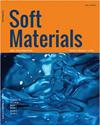小角度X射线散射研究浓度和离子强度对聚N-异丙基丙烯酰胺溶液下临界温度的影响
IF 1.4
4区 材料科学
Q4 MATERIALS SCIENCE, MULTIDISCIPLINARY
引用次数: 1
摘要
摘要热响应聚合物,特别是聚N-异丙基丙烯酰胺(PNIPAAM),由于其在物理和聚合物化学的许多领域中的潜在应用,一直是研究的焦点。PNIPAAM的“较低临界溶液温度”为32°C。LCST可以通过与疏水性或亲水性共聚单体共聚,并通过改变物理化学参数(如溶液的离子强度)进行微调。我们用相对低分子质量聚合物的小角度X射线散射(SAXS)研究了在纯水和50mM NaCl溶液中两种不同溶液环境中聚合物浓度对LCST的影响。我们发现,由于氯离子在聚合物上的比吸附水平较低,pNIPAAM链的回转半径随着向体系中加入NaCl而增加,同时温度的升高会导致聚合物链的收缩。此外,通过提高温度,单个聚合物链之间的吸引力相互作用增强,在LCST处转变为聚集。本文章由计算机程序翻译,如有差异,请以英文原文为准。
Effect of concentration and ionic strength on the lower critical solution temperature of poly(N-isopropylacrylamide) investigated by small-angle X-ray scattering
ABSTRACT Thermoresponsive polymers, with special emphasis on poly(N-isopropylacrylamide) (PNIPAAM) have been the focus of several investigations due to its potential applications in many fields of physical and polymer chemistry. PNIPAAM has a “lower critical solution temperature” at 32°C. The LCST can be finely tuned by copolymerization with hydrophobic or hydrophilic comonomers, and with a change of physical chemical parameters, such as ionic strength of the solution. We investigated the effect of polymer concentration on the LCST in two different solution environment, in pure water and in 50 mM NaCl solution with small-angle X-ray scattering (SAXS) of relatively low molecular mass polymers. We showed that the radius of gyration of the pNIPAAM chains increases with the addition of NaCl to the system due to the low level of specific adsorption of chloride ions on the polymer, whilst increasing the temperature causes a shrinkage of the polymer chains. Furthermore, by increasing the temperature the attractive interaction between the individual polymer chains is enhanced which turns into aggregation at the LCST.
求助全文
通过发布文献求助,成功后即可免费获取论文全文。
去求助
来源期刊

Soft Materials
工程技术-材料科学:综合
CiteScore
2.90
自引率
0.00%
发文量
21
审稿时长
2.2 months
期刊介绍:
Providing a common forum for all soft matter scientists, Soft Materials covers theory, simulation, and experimental research in this rapidly expanding and interdisciplinary field. As soft materials are often at the heart of modern technologies, soft matter science has implications and applications in many areas ranging from biology to engineering.
Unlike many journals which focus primarily on individual classes of materials or particular applications, Soft Materials draw on all physical, chemical, materials science, and biological aspects of soft matter. Featured topics include polymers, biomacromolecules, colloids, membranes, Langmuir-Blodgett films, liquid crystals, granular matter, soft interfaces, complex fluids, surfactants, gels, nanomaterials, self-organization, supramolecular science, molecular recognition, soft glasses, amphiphiles, foams, and active matter.
Truly international in scope, Soft Materials contains original research, invited reviews, in-depth technical tutorials, and book reviews.
 求助内容:
求助内容: 应助结果提醒方式:
应助结果提醒方式:


